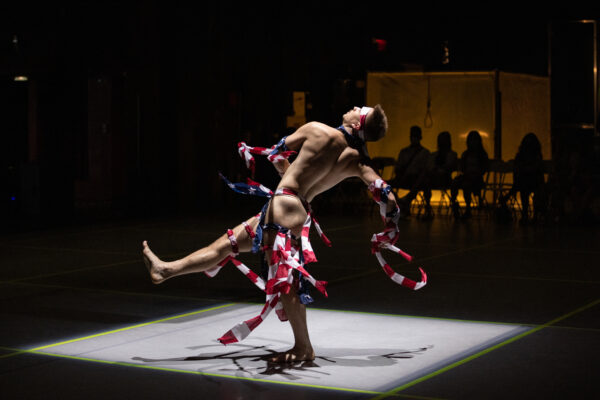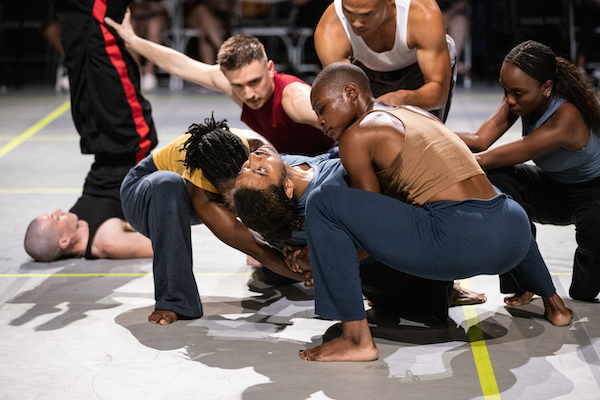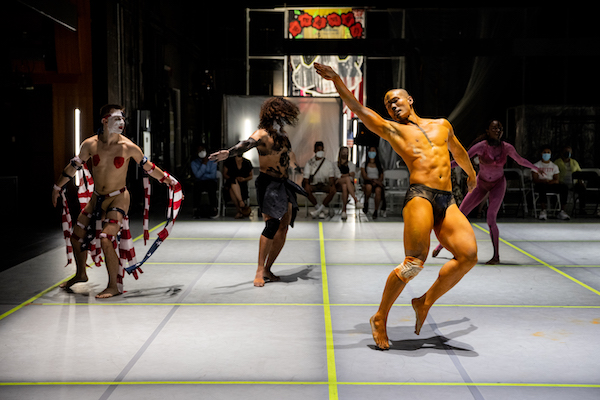Dance Review: Bill T. Jones’ “Curriculum II” — Visceral Meditations on the Intersection of Race and Technology
By Thea Singer
Bill T. Jones/Arnie Zane Company’s Curriculum II is no intellectual exercise. It is a gut-wrenching journey into the heart of darkness, offset by flashes of compassion and light.
No one seems to care as much
No time to smile, laugh or cry as much
Have we lost the touch that means so much
Have we lost the human touch
—Nina Simone, “The Human Touch”
How, in a world shaped by slavery, colonialism, and industrialization — a world terrified of “the other” (whether people or machines) — can you maintain your humanity, live responsibly, morally? In other words: How do you live in America in 2023?
In the now plangent, now battering Curriculum II (presented March 10–12 at the Institute of Contemporary Art), choreographer Bill T. Jones attempts to answer that question. To do so, he tunnels through the paired histories of race and technology using spoken words, song, video snippets suspended in a box on high, and movement where even nanoscale shifts in weight carry the force of a riptide.

A scene from the Bill T. Jones/Arnie Zane Company’s performance of Curriculum II. Photo: Maria Baranova
This is no intellectual exercise on the part of the Bill T. Jones/Arnie Zane Company. It is a gut-wrenching journey into the heart of darkness, offset by flashes of compassion and light. At its core, there’s this lesson:
“On or about December 1835, American popular culture could be said to have begun,” writes Nigerian-born scholar Louis Chude-Sokei, in the first chapter of his book The Sound of Culture: Diaspora and Black Technopoetics. It is one of four sources from which Jones adapted text for the piece. In July of that year, Chude-Sokei writes, “the notorious P.T. Barnum, ‘bought’ or acquired the rights to display the slave woman Joice Heth, so-called mammy to George Washington, allegedly 161 years old.” That December, he notes, Barnum brought Joice Heth, “a human reduced to an object” to Boston and displayed her alongside the “infamous chess-playing machine ‘The Turk,’ an object raised to the querulous status of human.”
Text fragments about Heth as object — later, as automaton — bounced off the walls of the ICA’s Barbara Lee Family Foundation Theatre. At first mention of Heth’s dehumanization, the riveting Jeda Jenai, one of the troupe’s 10 full-throttle dancers, drops to her shoulder in a small square of light, her legs aloft in a swirl, then settles on elbows and knees and pounds a foot, hard, into the floor. It rattles your bones. “Call it culture,” we hear, as dancer Shane Larsen appears. He’s a white man who earlier, in red knit beanie, introduced himself as “a narrator.” “You can call me Louis or Sylvia, or Bill,” he intoned. “I am the intruder, the other made flesh. You need to picture me as Black.” “Sylvia” is likely Caribbean critic Sylvia Wynter; “Louis,” Chude-Sokei; “Bill,” Bill T. Jones — all thinkers concerned with the repercussions from the complicated relationship of race and technology.

A scene from the Bill T. Jones/Arnie Zane Company’s performance of Curriculum II. Photo: Maria Baranova
The piece begins with the dancers leaving their seats in the audience while holding up phones with their flashlights on. From the get-go, we, too, “are part of the spectacle” (a phrase we hear later). Marie Lloyd Paspe, a small woman in red sweat pants with a white stripe on the side, leaves her seat in my row, passes my bent knees, and descends to the stage, joining other dancers. She sings Jonathan King’s “Everyone’s Gone to the Moon,” her voice crystalline: “Streets full of people, all alone/Roads full of houses, never home/Church full of singing, out of tune…” The dancers spin in individual spaces in the dark, faster and faster, lit only by the flickers of light from their phones: They are celestial bodies, perhaps rotating toward the sun — a turn toward warmth after a freeze.
The rhythm is quickly broken with God’s thundering commandment in Genesis to “subdue” the Earth and have “dominion over” all of nature. It’s a comment on how we are playing God by ravaging nature, including breaching the boundary between “the natural and unnatural,” as Mark O’Connell puts it in his essay, “Uncanny Planet,” also a source for Jones. We genetically engineer plants (think soybeans, corn) and animals (think AquAdvantage Salmon). “Today’s machines become tomorrow’s human beings,” Larsen tells us later. ChatGPT, anyone? Or Ray Kurzweil’s Singularity?
The movement, as in much of Jones’s work, is idiosyncratic, collaborative: every joint is employed, every body part tells a story juxtaposed against another story in a series of kinesthetic conversations. A few examples: The white supremacist slogan “You will not replace us” hovers above scenes of just such replacement: four dancers, upright in a diamond shape, are each pushed aside, one by one, then two by two, by others’ intrusions. The stage space expands and shrinks, as players enter and leave, a revolving door of permutations. Beautiful and bold, Nayaa Opong and Huiwang Zhang, both on their knees, shift into sitting, bent legs fore and aft, then rise, one hand on a hip, and in relevé walk upstage in mincing steps, one behind the other. Their line doubles in length as two others join the trek. A film clip of refugees fills the video screen.

A scene from the Bill T. Jones/Arnie Zane Company’s performance of Curriculum II. Photo: Maria Baranova
The juxtaposition of elements says as much about the creation of a dance as about our history. The soundscape and ideas shape the piece’s vocabulary and architecture and, in turn, the phrases, patterns, and tempi of the choreography shape the interpretation of those ideas, chants, and songs. It’s a bidirectional commitment. Consider: Jenai, mike in hand, sings Nina Simone’s “The Human Touch.” Four dancers surround her, their legs swinging, circling, angling into deep pliés. They touch a hand bent at the wrist to their hearts, then leave. “No one wants to live alone,” Jenai sings, then crumbles and sinks to the floor still clutching the mike. “Have we lost the human touch that means so much?”
Jones’s answer seems to be: almost, but not quite. Paired and full-group configurations of the cast speak of communion, albeit with an edge. Paspe and Jacoby Pruitt, a tall man in blue pants with hair that stands up from his head, perform an angular duet: they dart an arm between their knees, wag their heads, shoot into long flat backs, then stretchy arabesques, the extended leg lifted skyward by the other. On the balls of their feet, legs set to stride, they face each other from distant corners of the stage: there is hope for that touch, if we listen and learn.
There is no way, of course, you can absorb or even identify all of the references in a single viewing, despite their appearance in the program. As the evening progresses, the sirens and cacophony of the January 6 Capitol attack give way to the longing of the human heart via Bessie Jones and the Georgia Sea Island Singers’ “Beulah Land.” Daniel Decatur Emmett’s “Dixie,” first performed by the blackface minstrel troupe Bryant’s Minstrels in New York in 1859, throws wide the door to the roar of Caliban, the “monster” slave, addressing Prospero, his master, in Shakespeare’s The Tempest. At one point, Larsen comments: “The other must be understood as that which is to come.”

A scene from the Bill T. Jones/Arnie Zane Company’s performance of Curriculum II. Photo: Maria Baranova
At the end of Curriculum II, the cast descends to the stage, their bodies painted in shades of green, blue, silver, and more (a twist on blackface?). Paspe walks on, reprising the song that opened the dance: “Long time ago/Life had begun/Everyone went to the sun…” She stops, points a hand to her breast, then to her forehead, drops to pushups with ankles crossed. The others, now multicolored, surround her. “Everyone’s gone to the moon.”
By this point, you are stunned, shaken. I burst into tears: so much violence, so many horrific stories carried in the dancers’ remarkable bodies and voices and kinesthetically transferred to mine.
Race and technology. How many of us think often about that, including — as Chude-Sokei and in turn Jones show us — how music links Blacks and machines, and how racial anxieties inform science fiction and even science (think: robots, automatons, the decades-long use of the engineering terms “master” and “slave” to describe the relationship between various components)? We have to be taught. Curriculum II wakes us up, often roughly, and gives us that emotional education.
Thea Singer is a longtime dance critic and science writer based in Brookline, MA. Her articles have appeared in numerous publications including the Washington Post, Boston Globe, Scientific American, MORE magazine, O the Oprah magazine, Psychology Today, Huffington Post, Boston magazine, the Daily Beast, and Nature Outlook.
Tagged: Bill T. Jones, Bill T. Jones/Arnie Zane Company, Black dancers, Curriculum II, humanity, machine, race
